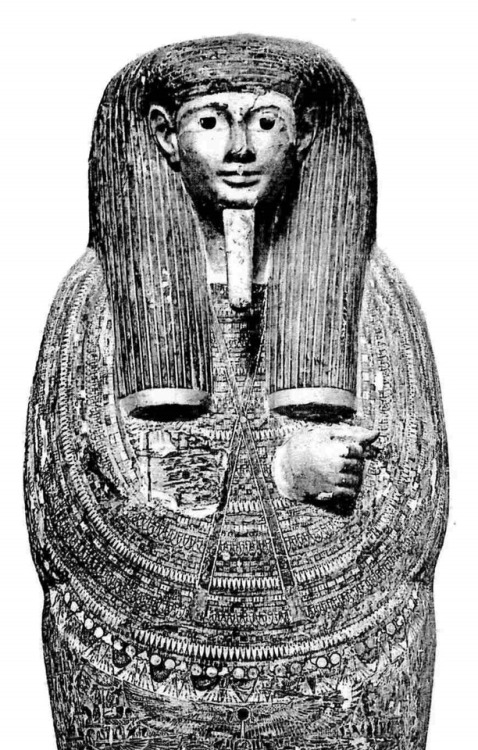spiritsdancinginthenight: Djed-Ptah-Iuf-AnkhHigh-Priest (?)21st - 22nd Dynasty, Egypt, c. 935 B.C.
spiritsdancinginthenight: Djed-Ptah-Iuf-AnkhHigh-Priest (?)21st - 22nd Dynasty, Egypt, c. 935 B.C. Djedptahiufankh’s connection to the Pinudjem family seems to be that he was married to the Lady Nestanebtishru. Inscriptions on his coffins identify him as a priest of Amen and holder of a rather peculiar title, “Royal Son of Ramesses.” Hieratic notations on his mummy wrappings can be dated to Years 5, 10, and 11 of Sheshonq I, meaning that Djedptahiufankh lived some half way through the first reign of the Twenty-Second (or Libyan) Dynasty headquartered at Bubastis. The undisturbed condition of his coffins and mummy suggest that he was buried directly in TT320, probably in Sheshonq I’s eleventh or twelfth year rule. Thus, he was undoubtedly the last of the Pinudjem-related individuals to be interred there; and it has been suggested that it was probably on the occasion of Djedptahiufankh’s burial that the final reopening of TT320 took place and the deposit of the New Kingdom royal and associated mummies therein was affected.Gaston Maspero partially unwrapped No. 61097 in 1886, and Elliot Smith completed the job on September 5, 1906, bringing to light a large number of stone amulets and other objects contained within the bandaging. Djedptahiufankh’s fingers and toes also bore several band-like gold rings, which Smith thought had been employed to hold the nails in place during mummification. Maspero had likewise found items of jewellery on the mummy during his partial unwrapping. The body had been treated in the manner common during the Third Intermediate Period, although packaging of the limbs is minimal; the buttocks and anterior surface of the torso are untreated. The body cavity is stuffed with lichen, within which were found three bundles of the priests mummified viscera (intestines, liver and kidneys). Only one of these (the intestines) was accompanied by the figure of a funerary genie (an ape-headed Hapi). Djedptahiufankh’s mouth is packed with sawdust and artificial stone eyes are inserted behind the half-open eyelids. The priest’s rather large aquiline nose has been flattened somewhat by a tight bandaging. Both ears seem to have been pierced but are thickly smeared with resin and mostly hidden under the mummy’s hair. The mustache and beard had not been shaven for some days before the death; these are reddish brown, the same colour as the head hair. The latter, thickly plastered with resin, is longish, curled into pendant wisps, and without any trace of greying or thinning. This coupled with the unworn condition of the four teeth visible would suggest that Djedptahiufankh was relatively young at death. The priest would have stood about 1.695m. (5 ft. 6.73 in.) tall in life. Tombs. Treasures. Mummies.Seven Great Discoveries of Egyptian Archaeology.Book Five: Complete Catalogue of the Royal Mummies, plus 7 Addenda© Dennis C. Forbes, 1998 & 2016. -- source link
Tumblr Blog : spiritsdancinginthenight.tumblr.com





